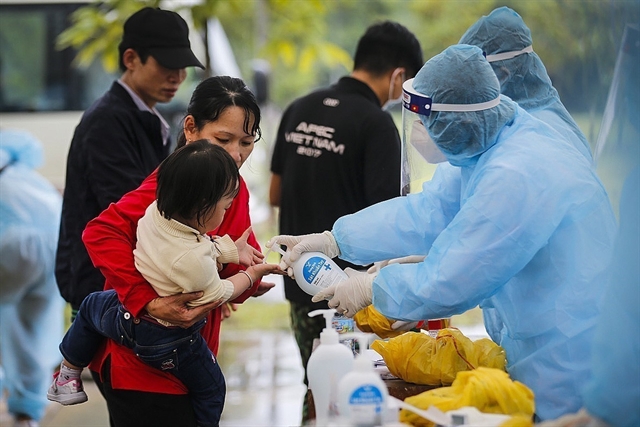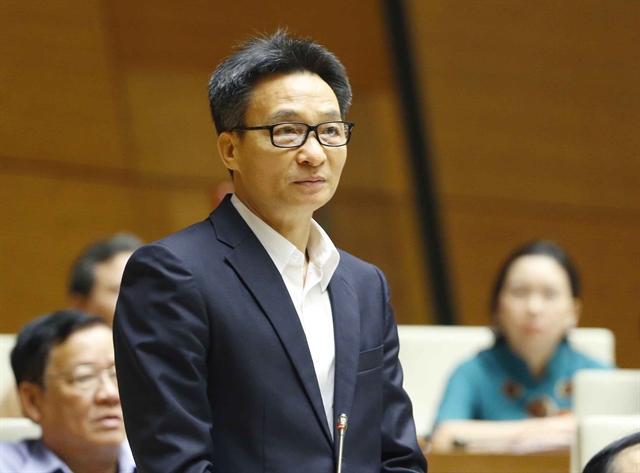 Society
Society


|
| Hand sanitation for Vietnamese citizens returning from Russia who were immediately quarantined on arrival at a military facility in the northern province of Hoà Bình. — VNA/VNS Photo Trọng Đạt |
HÀ NỘI — Việt Nam will continue to focus on COVID-19 prevention measures and safe living during the pandemic.
The message comes as the coronavirus situation worsens worldwide and the prospects of early access to vaccine hanging in the balance.
Deputy Prime Minister Vũ Đức Đam, chair of the National Steering Committee for COVID-19 Prevention and Control, was speaking during a National Assembly’s question and answer session on Friday in Hà Nội, as Việt Nam marks 65 days of no locally transmitted infections and with the majority of its total caseload imported.
"We have implemented strict management of arrivals, illegal or legal alike," Đam said.
“Việt Nam has welcomed home since the beginning of the pandemic roughly 200,000 people, both experts and workers necessary to economic development of the country, as well as returning Vietnamese including from regions severely impacted by the pandemic.
"This strict management efforts will need to be continued.”
Deputy PM Đam compared the current COVID-19 situation in the country to a “peaceful oasis” in the middle of a raging, tempestuous storm so what Việt Nam need to do is erecting a “solid, breach-proof embankment.”
Asked how long the pandemic would continue and on vaccine prospects, the Government official said he expected the pandemic to last at least until the end of 2021.
"The usual time to develop a vaccine is between five and 10 years, with several processes involved to determine the effectiveness of the vaccine as well as whether the vaccine would result in any unwanted or dangerous side effects," he said.
As per WHO, there are about 150 COVID-19 vaccine candidates under development in several countries in ‘expedited procedures’ in a rush to return to normal life.
Việt Nam currently had four candidates, with two front-runners expected to start small-scale human trials later this year, after positive trial results seen in small rodents and ongoing trial in primates, Deputy PM Đam said.
However, he cautioned that even if the development goes well, the best-case scenario for a domestically made vaccine would be commencing production in late 2021 and early 2022.
He also wasn’t much too optimistic about easy access to the promising COVID-19 vaccines that are already in late-stage human trial.
Buying vaccines from other countries would be difficult, but Việt Nam had been in direct talks with China, Russia, and vaccine companies regarding their potential deals, Đam said.
“Early securing of vaccines is not easy since the demands greatly exceed manufacturers’ capacity and there is still nothing totally certain about whether the vaccine will truly work,” Đam continued, adding that Governments around the world needed to make large deposits or advance payments for their order knowing full well that the risks are so high.
Đam said Việt Nam had also “obviously” joined the WHO-led COVAX initiative – The COVID-19 Vaccines Global Access Facility – representing global efforts to ensure equitable and fair distribution of coronavirus vaccine to developing countries.
Via subsidisation, the lower-income countries could get access to COVID-19 vaccines at just US$2 a shot – or $4 for a double-dose necessary to gain immunity – but the prospect for this access to COVID-19 vaccine is also not great given that currently, there has been no manufacturer committed to deliver their vaccines via the initiative so far, according to Đam.

|
| Deputy Prime Minister Vũ Đức Đam at Friday National Assembly meeting. — VNA/VNS Photo |
With COVID-19 vaccine prospects uncertain, the principal measure now is to continue with prevention efforts and promoting safe living with the pandemic, which Việt Nam is committed to.
Deputy PM Đam "strongly pleaded" with leaders of ministries and localities to not fall into a sense of complacency in order to "maintain the current calm state."
He reiterated the health ministry’s 5K message of “Khẩu trang (facemask) – Khử khuẩn (disinfection) – Khoảng cách (distance) – Không tụ tập (no large gathering) – Khai báo y tế (health declaration)” as important ways to help citizens get used to living safely with COVID-19 in a ‘new normal’ state.
All medical centres, elder care homes, schools, accommodation facilities, markets, workplaces, and factories, and transportation vehicles needed to strictly follow hygiene and safety measures, Đam said.
Since the total border closures imposed in late March to prevent the spread of the virus, Việt Nam has gradually taken steps to reopen to some selected groups of arrivals – including diplomats, business executives and investors, highly skilled workers, overseas students, or returning Vietnamese.
It had in mind the resumption of regular commercial flights starting September with a number of Asian countries and territories – those deemed important partners that also have a good handle on the coronavirus – but the plan is currently on hold pending complete medical procedures to avoid the virus entering the community.
Việt Nam has received praise from the international community for its COVID-19 response, thanks to a robust contact tracing, strict isolation and quarantine protocols, strong Government's efforts, consistent public health messages and successes in engaging the public in the fight against the pandemic. — VNS